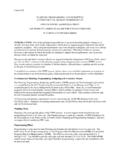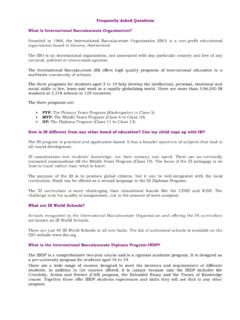Transcription of NEPA – Public Comment Requirements - SIkes Home
1 nepa Public Comment Requirements draft and Final Review At these stages, collaboration is more focused and likely more formalized, especially if effective collaboration has been used in all stages leading up to the formal Public Comment and review periods. The Public review and Comment periods and their concurrent Public engagement for the draft or Final EIS or EA might involve: A series of focused workshops to get more detailed feedback than standard Public meetings. Meetings with individual groups to explain the draft nepa document and obtain feedback. Multiple means to receive Public Comment such as letters and electronic (internet) comments . Receiving feedback from organized groups such as the cooperating agencies, resource advisory councils, or advisory groups.
2 The Public review phase might also provide an opportunity to establish and build internal and interagency leadership commitment. Once comments are received, the lead agency could collaboratively consider comments received on a draft or Final EIS or EA with other cooperating agencies and collaborating entities before issuing the final ROD or FONSI. The Public must be notified of its privacy rights. Include the following statement in all information requesting Public Comment : Before including your address, phone number, e-mail address, or other personal identifying information in your Comment , be advised that your entire Comment including your personal identifying information may be made publicly available at any time.
3 While you can ask us in your Comment to withhold from Public review your personal identifying information, we cannot guarantee that we will be able to do so. Involving and Notifying the Public The CEQ regulations require that agencies make diligent efforts to involve the Public in preparing and implementing their nepa procedures (40 CFR (a)). There are a wide variety of ways to engage the Public in the nepa process. A primary goal of Public involvement is to ensure that all interested and affected parties are aware of your proposed action. Knowing your community well is the first step in determining the interested and affected parties and tribes. You may already have a core list of those interested in and potentially affected by the BLM's proposed actions; this may provide a good starting point.
4 Work with your Public affairs officer and other BLM staff, community leaders, and governmental agencies (Federal, State, and local) to help determine interested and affected parties and tribes. Public meetings or hearings are required when there may be substantial environmental controversy concerning the environmental effects of the proposed action, a substantial interest in holding the meeting, or a request for a meeting by another agency with jurisdiction over the action (40 CFR (c)). You may determine that it is efficient to combine Public meetings for the nepa with hearings required by another law (an example is Requirements in the Alaska National Interest Lands Conservation Act that require hearings if certain findings are made regarding the effects of a proposed action on subsistence).
5 There are more stringent Requirements for conducting the hearing and recording the proceedings. You must maintain records of Public meetings and hearings including a list of attendees (as well as addresses of attendees desiring to be added to the mailing list) and notes or minutes of the proceedings. Consult 455 DM 1 for procedural Requirements related to Public hearings. Check individual program guidance to determine Requirements for Public meetings and hearings. In many cases, people attending field trips and Public meetings will be interested and/or affected parties. Make sure that you have attendance sheets that capture contact information at your field trips and meetings; these will provide you with a list of people who may want to be contacted about and involved in the nepa process.
6 In some cases, those affected by your proposed action may not be actively engaged in the nepa process. In these cases, it is still important for you to reach out to those individuals, Notification methods include, but are not limited to: newsletters, Web sites or online nepa logs, bulletin boards, newspapers, and Federal Register Notices. EISs have very specific notification Requirements . The CEQ regulations explicitly discusses agency responsibility towards interested and affected parties at 40 CFR The CEQ regulations require that agencies shall: (a) Make diligent efforts to involve the Public in preparing and implementing their nepa procedures (b) Provide Public notice of nepa -related hearings, Public meetings, and the availability of environmental documents so as to inform those persons and agencies who may be interested or affected.
7 In all cases the agency shall mail notice to those who have requested it on an individual action. In the case of an action with effects of national concern notice shall include publication in the Federal Register and notice by mail to national organizations reasonably expected to be interested in the matter and may include listing in the 102 Monitor. An agency engaged in rulemaking may provide notice by mail to national organizations who have requested that notice regularly be provided. Agencies shall maintain a list of such organizations. In the case of an action with effects primarily of local concern the notice may include: (i) Notice to State and areawide clearinghouses pursuant to OMB Circular A- 95 (Revised).
8 (ii) Notice to Indian tribes when effects may occur on reservations. (iii) Following the affected State's Public notice procedures for comparable actions. (iv) Publication in local newspapers (in papers of general circulation rather than legal papers). (v) Notice through other local media. (vi) Notice to potentially interested community organizations including small business associations. (vii) Publication in newsletters that may be expected to reach potentially interested persons. (viii) Direct mailing to owners and occupants of nearby or affected property. (ix) Posting of notice on and off site in the area where the action is to be located. (c) Hold or sponsor Public hearings or Public meetings whenever appropriate or in accordance with statutory Requirements applicable to the agency.
9 Criteria shall include whether there is: (i) Substantial environmental controversy concerning the proposed action or substantial interest in holding the hearing. (ii) A request for a hearing by another agency with jurisdiction over the action supported by reasons why a hearing will be helpful. If a draft environmental impact statement is to be considered at a Public hearing, the agency should make the statement available to the Public at least 15 days in advance (unless the purpose of the hearing is to provide information for the draft environmental impact statement). parties, or tribes, and we recommend using a variety of methods to help inform and engage those affected.
10 (d) Solicit appropriate information from the Public . (e) Explain in its procedures where interested persons can get information or status reports on environmental impact statements and other elements of the nepa process. (f) Make environmental impact statements, the comments received, and any underlying documents available to the Public pursuant to the provisions of the Freedom of Information Act (5 552), without regard to the exclusion for interagency memoranda where such memoranda transmit comments of Federal agencies on the environmental impact of the proposed action. Materials to be made available to the Public shall be provided to the Public without charge to the extent practicable, or at a fee which is not more than the actual costs of reproducing copies required to be sent to other Federal agencies, including the Council.








